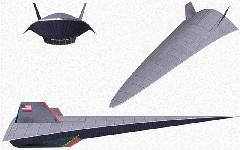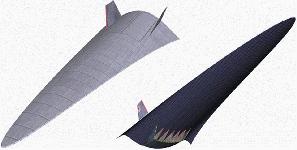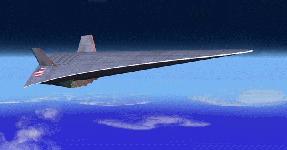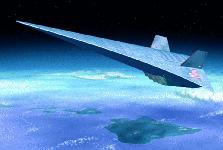A HyperSoar hypersonic Global Range Recce/Strike Aircraft the size
of a B-52 could take off from the US and deliver its payload to any
point on the globe - from an altitude and at a speed that would
challenge current defensive measures - and return to the US without
the need for refueling or forward bases on foreign soil. Equipment and
personnel could also be transported.
HyperSoar could fly at approximately 6,700 mph (Mach 10), while carrying roughly twice the payload of subsonic aircraft of the same takeoff weight.
The HyperSoar concept promises less heat build-up on the airframe than previous hypersonic designs - a challenge that has until now limited the development of hypersonic aircraft. The key to HyperSoar is the skipping motion of its flight along the edge of Earth's atmosphere - much like a rock skipped across water. A HyperSoar aircraft would ascend to approximately 130,000 feet - lofting outside the Earth's atmosphere - then turn off its engines and coast back to the surface of the atmosphere. There, it would again fire its air-breathing engines and skip back into space. The craft would repeat this process until it reached its destination.
A mission from the midwestern United States to east Asia would require approximately 25 such skips to complete the one-and-a-half-hour journey. The aircraft's angles of descent and ascent during the skips would only be 5 degrees. The crew would feel 1.5 times the force of gravity at the bottom of each skip and weightlessness while in space. (1.5 Gs is comparable to the effect felt on a child's swing, though HyperSoar's motion would be 100 times slower.) Although the porpoising effect of a HyperSoar flight might test the adventurousness of some airline passengers, this would not impact military or space launch applications.
Most current hypersonic designs rely on rocket engines to boost the aircraft to the edge of space, from where the craft essentially glides back down to its destination. Other designs simply use engines to push the aircraft through the atmosphere.
All previous concepts have suffered from heat buildup on the surface of the aircraft and in various aircraft components due to friction with the atmosphere. A HyperSoar plane would experience less heating because it would spend much of its flight out of the Earth's atmosphere. Also, any heat the craft picked up while "skipping" down into the atmosphere could be at least partially dissipated during the aircraft's time in the cold of space.
Another HyperSoar advantage is its use of air-breathing engines. Most conventional hypersonic designs rely on rocket motors to boost the aircraft to the edge of space. By not boosting to as high a velocity, and by dropping back into the atmosphere at the bottom of each "skip," a HyperSoar plane can utilize air- breathing engines, which are inherently more efficient than rocket engines. Also, HyperSoar engines would be used strictly as accelerators, rather than as accelerators and cruising engines - as in some hypersonic designs - thereby greatly simplifying the design and reducing technical risk.
Waveriders are aerodynamic shapes designed such that the bow shock generated by the configuration is attached along the outer leading edge at the design Mach number. The shock attachment condition confines the high-pressure region behind the shock wave to the lower surface of the configuration, which provides the potential for high lift-to-drag ratios. Waveriders also offer potential propulsion/airframe integration (PAI) benefits because of their ability to deliver a known uniform flow field to a scramjet inlet.
Enhanced mixing mixing between the fuel and airstream, and thus reduced combustor length and engine weight, is an important goal in the design of supersonic combustion ramjet (scramjet) engines. Cryogenic hydrogen fuel was chosen for air-breathing scramjet propulsion for the National AeroSpace Plane. Selection was based on its high specific energy, its high heat-sink capacity for structural cooling, and its ability to burn very rapidly and sustain flameholding in strained recirculation zones.
The HyperSoar concept has been under investigation by Lawrence Livermore National Laboratory for several years and is being discussed with the US Air Force and other government agencies. Livermore has been working with the University of Maryland's Department of Aerospace Engineering to refine the aerodynamic and trajectory technologies associated with the concept.
Other potential applications for HyperSoar aircraft include:




HyperSoar could fly at approximately 6,700 mph (Mach 10), while carrying roughly twice the payload of subsonic aircraft of the same takeoff weight.
The HyperSoar concept promises less heat build-up on the airframe than previous hypersonic designs - a challenge that has until now limited the development of hypersonic aircraft. The key to HyperSoar is the skipping motion of its flight along the edge of Earth's atmosphere - much like a rock skipped across water. A HyperSoar aircraft would ascend to approximately 130,000 feet - lofting outside the Earth's atmosphere - then turn off its engines and coast back to the surface of the atmosphere. There, it would again fire its air-breathing engines and skip back into space. The craft would repeat this process until it reached its destination.
A mission from the midwestern United States to east Asia would require approximately 25 such skips to complete the one-and-a-half-hour journey. The aircraft's angles of descent and ascent during the skips would only be 5 degrees. The crew would feel 1.5 times the force of gravity at the bottom of each skip and weightlessness while in space. (1.5 Gs is comparable to the effect felt on a child's swing, though HyperSoar's motion would be 100 times slower.) Although the porpoising effect of a HyperSoar flight might test the adventurousness of some airline passengers, this would not impact military or space launch applications.
Most current hypersonic designs rely on rocket engines to boost the aircraft to the edge of space, from where the craft essentially glides back down to its destination. Other designs simply use engines to push the aircraft through the atmosphere.
All previous concepts have suffered from heat buildup on the surface of the aircraft and in various aircraft components due to friction with the atmosphere. A HyperSoar plane would experience less heating because it would spend much of its flight out of the Earth's atmosphere. Also, any heat the craft picked up while "skipping" down into the atmosphere could be at least partially dissipated during the aircraft's time in the cold of space.
Another HyperSoar advantage is its use of air-breathing engines. Most conventional hypersonic designs rely on rocket motors to boost the aircraft to the edge of space. By not boosting to as high a velocity, and by dropping back into the atmosphere at the bottom of each "skip," a HyperSoar plane can utilize air- breathing engines, which are inherently more efficient than rocket engines. Also, HyperSoar engines would be used strictly as accelerators, rather than as accelerators and cruising engines - as in some hypersonic designs - thereby greatly simplifying the design and reducing technical risk.
Waveriders are aerodynamic shapes designed such that the bow shock generated by the configuration is attached along the outer leading edge at the design Mach number. The shock attachment condition confines the high-pressure region behind the shock wave to the lower surface of the configuration, which provides the potential for high lift-to-drag ratios. Waveriders also offer potential propulsion/airframe integration (PAI) benefits because of their ability to deliver a known uniform flow field to a scramjet inlet.
Enhanced mixing mixing between the fuel and airstream, and thus reduced combustor length and engine weight, is an important goal in the design of supersonic combustion ramjet (scramjet) engines. Cryogenic hydrogen fuel was chosen for air-breathing scramjet propulsion for the National AeroSpace Plane. Selection was based on its high specific energy, its high heat-sink capacity for structural cooling, and its ability to burn very rapidly and sustain flameholding in strained recirculation zones.
The HyperSoar concept has been under investigation by Lawrence Livermore National Laboratory for several years and is being discussed with the US Air Force and other government agencies. Livermore has been working with the University of Maryland's Department of Aerospace Engineering to refine the aerodynamic and trajectory technologies associated with the concept.
Other potential applications for HyperSoar aircraft include:
- Space lift - HyperSoar could be employed as the first stage of a two-stage-to- orbit space launch system. Research shows this approach will allow approximately twice the payload-to-orbit as today's expendable launch systems for a given gross takeoff weight.
- Passenger aircraft - A commercial HyperSoar airliner or business
jet could reach any destination on the planet from the continental
U.S. in two hours or less.
- Freighter - A HyperSoar freight aircraft could make four or more
roundtrips to, say, Tokyo each day from the U.S. versus one or less
for today's aircraft. Analysis indicates a HyperSoar aircraft flying
express mail between Los Angeles and Tokyo could generate ten times
the daily revenue of a similarly- sized subsonic cargo plane of
today.
Specifications | |










No comments:
Post a Comment